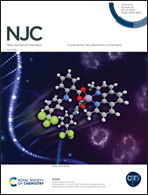Heteroleptic ruthenium(ii) complexes featuring N-heterocyclic carbene-based C^N donor sets for solar energy conversion†
Abstract
We present a series of heteroleptic ruthenium(II) complexes featuring N-heterocyclic carbene-based C^N donor sets functionalized with long hydrophobic chains (ndecyl and noctyl) and –NCS ligands. These complexes utilize mono or tri-carboxy terpyridine (tpy) ligands as anchors to bind with TiO2 photoanodes. Herein, the synthetic route preferably gave access to only the complexes with NHC and –NCS ligands in trans-orientation. The complexes exhibit a wider visible-light absorptivity tailing until 750 nm. Stronger electron donation from the C^N donor set and an –NCS ligand propel these metal-ligand-to-ligand charge transfer excitations, transferring the electron density toward the carboxylate anchors. We evaluate the performance of these NHC-based ruthenium complexes in a typical dye-sensitized solar cell setup. The electrochemical and photophysical attributes of the complexes underline their ability to convert solar energy into electricity. Furthermore, interfacial electron transport parameters obtained from electrochemical impedance spectroscopy give deeper insight into the performance of the devices. We also present our analyses from electronic-structure calculations to support the experimental results.



 Please wait while we load your content...
Please wait while we load your content...